Operations Management: A Comparative Analysis of Starbucks and Greggs
VerifiedAdded on 2022/09/09
|13
|4668
|31
Report
AI Summary
This report provides a comprehensive analysis of the operations management strategies employed by Starbucks and Greggs, two prominent players in the retail coffee and snacks industry. Part A delves into a comparative 'Four Vs' analysis, examining volume, visibility, variety, and variation to highlight the operational differences between the two companies. It also includes a comparative analysis of their performance objectives, focusing on quality, cost, dependability, flexibility, and speed. Furthermore, the report explores the design aspects of both companies, including customer service and store layout. Part B then shifts focus to Starbucks' global operations strategy, outlining its supply chain management, key requirements, capabilities, and challenges. The report concludes with an evaluation of Starbucks' resource management and offers recommendations for maintaining a competitive advantage in the market.
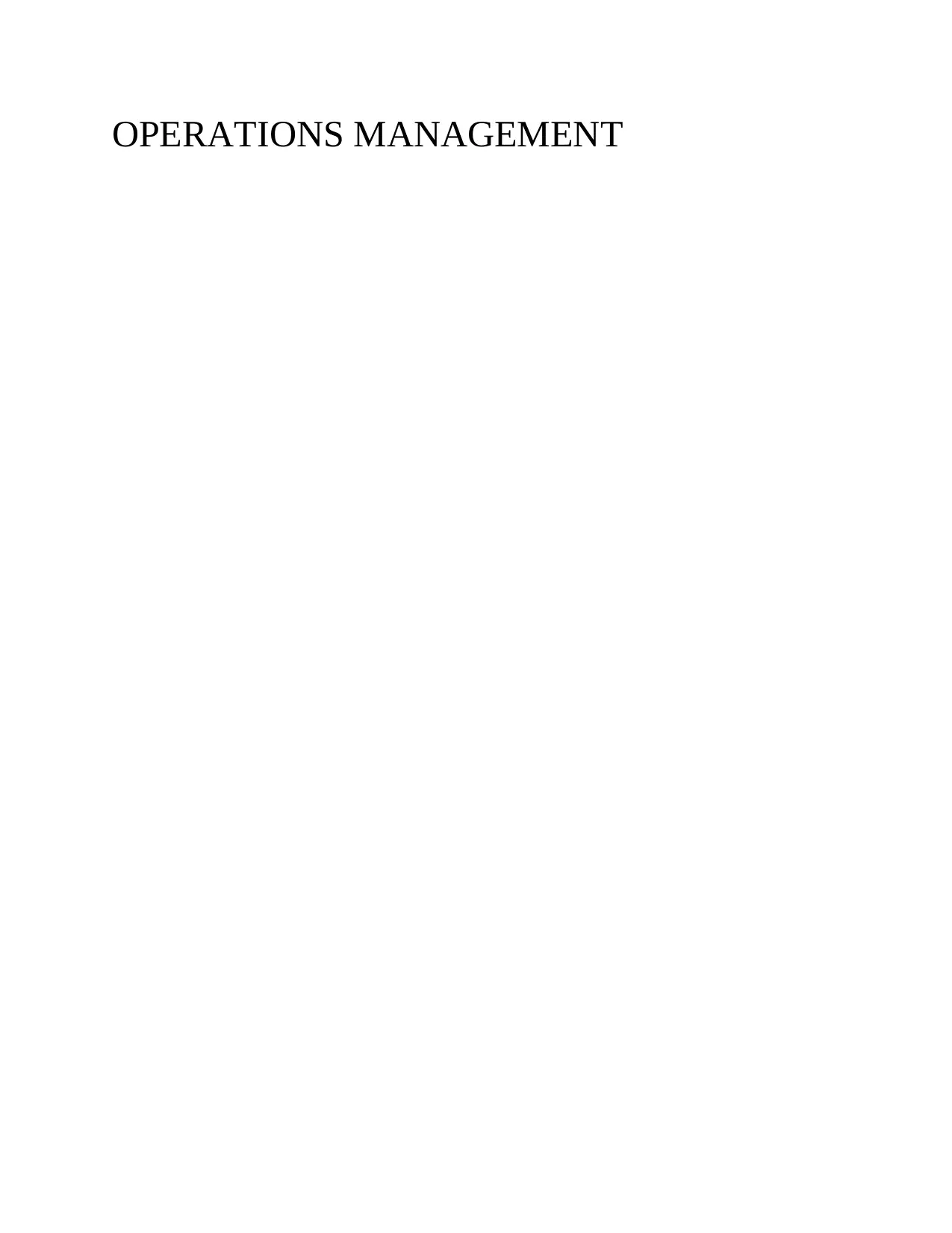
OPERATIONS MANAGEMENT
Paraphrase This Document
Need a fresh take? Get an instant paraphrase of this document with our AI Paraphraser
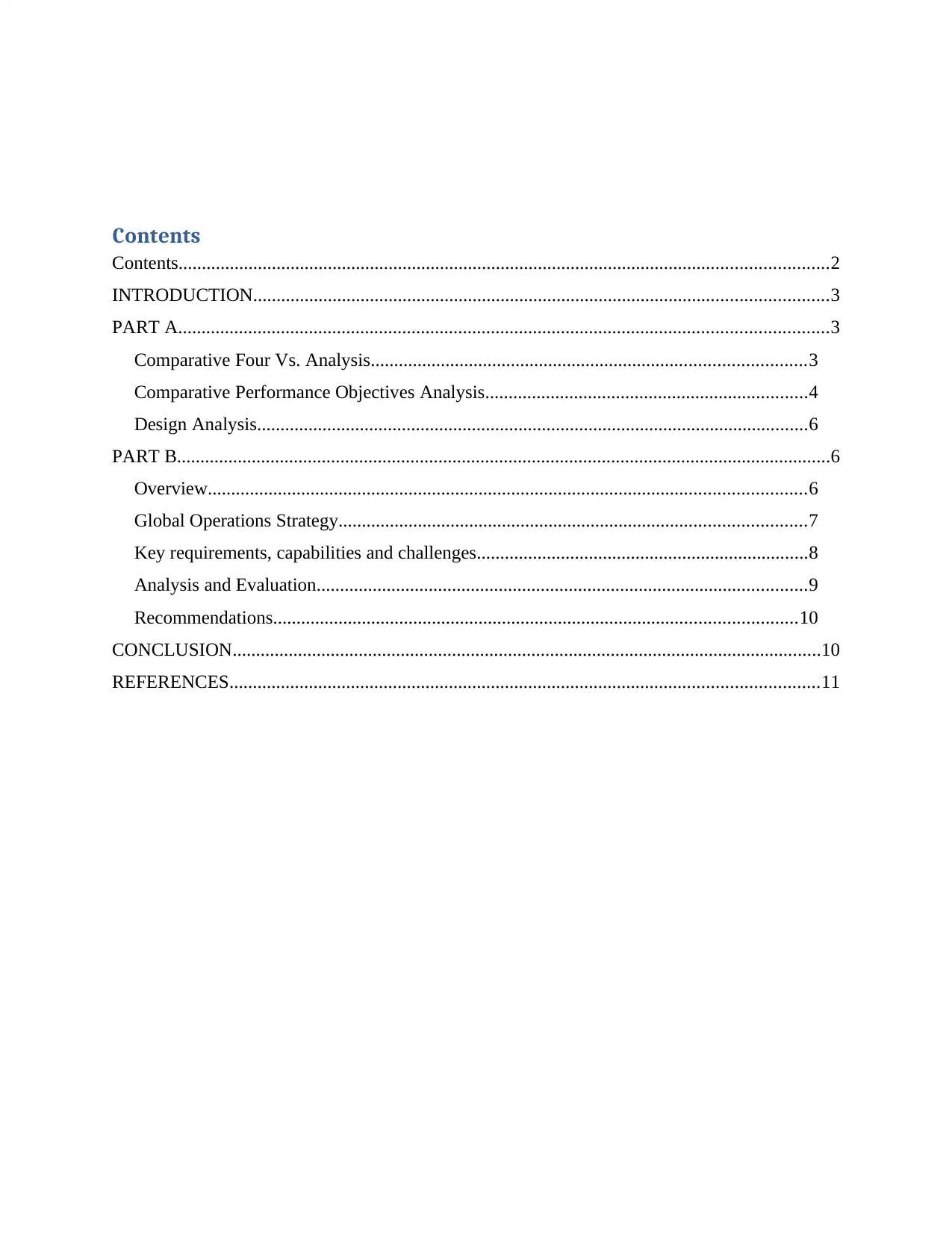
Contents
Contents...........................................................................................................................................2
INTRODUCTION...........................................................................................................................3
PART A...........................................................................................................................................3
Comparative Four Vs. Analysis.............................................................................................3
Comparative Performance Objectives Analysis.....................................................................4
Design Analysis......................................................................................................................6
PART B............................................................................................................................................6
Overview................................................................................................................................6
Global Operations Strategy....................................................................................................7
Key requirements, capabilities and challenges.......................................................................8
Analysis and Evaluation.........................................................................................................9
Recommendations................................................................................................................10
CONCLUSION..............................................................................................................................10
REFERENCES..............................................................................................................................11
Contents...........................................................................................................................................2
INTRODUCTION...........................................................................................................................3
PART A...........................................................................................................................................3
Comparative Four Vs. Analysis.............................................................................................3
Comparative Performance Objectives Analysis.....................................................................4
Design Analysis......................................................................................................................6
PART B............................................................................................................................................6
Overview................................................................................................................................6
Global Operations Strategy....................................................................................................7
Key requirements, capabilities and challenges.......................................................................8
Analysis and Evaluation.........................................................................................................9
Recommendations................................................................................................................10
CONCLUSION..............................................................................................................................10
REFERENCES..............................................................................................................................11
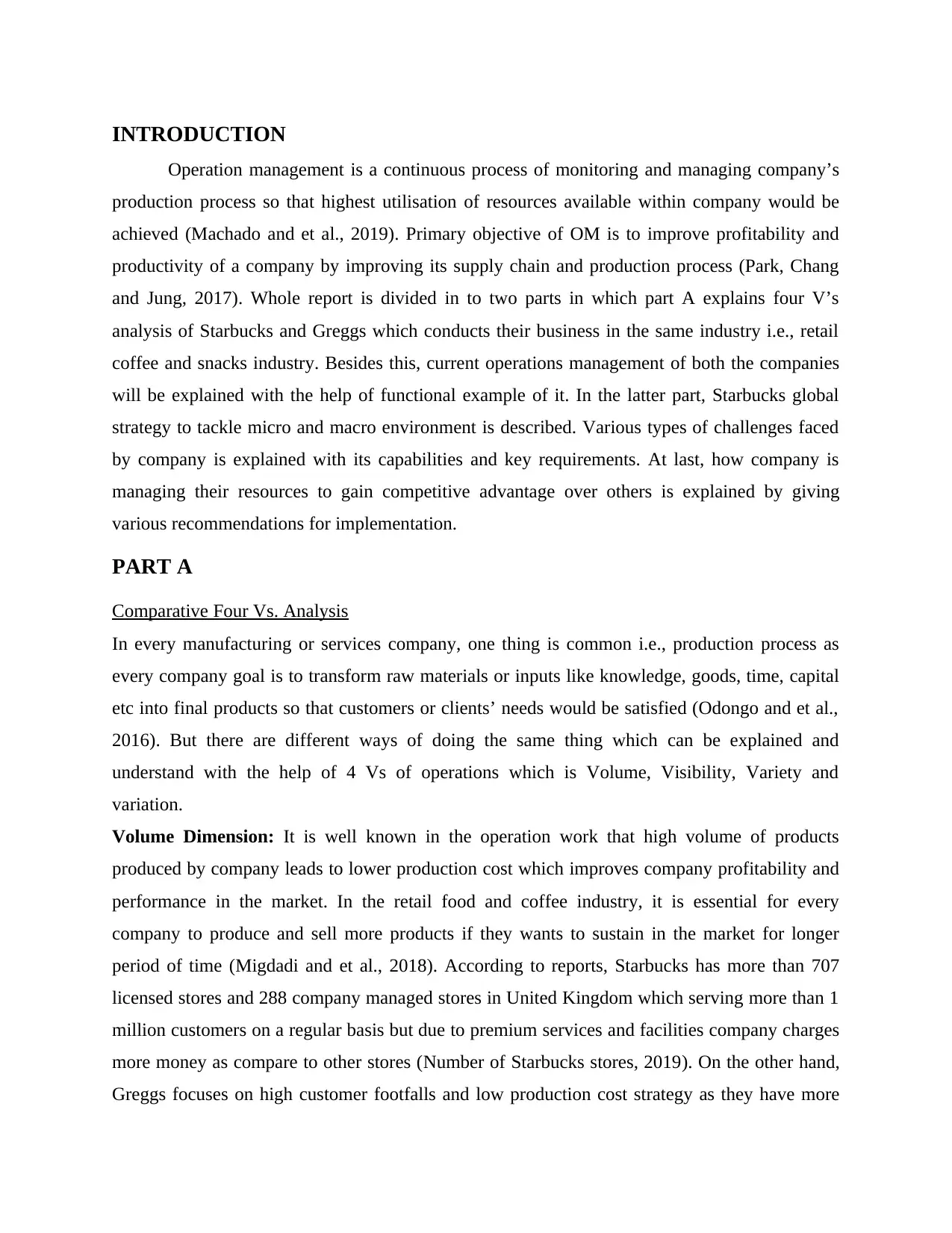
INTRODUCTION
Operation management is a continuous process of monitoring and managing company’s
production process so that highest utilisation of resources available within company would be
achieved (Machado and et al., 2019). Primary objective of OM is to improve profitability and
productivity of a company by improving its supply chain and production process (Park, Chang
and Jung, 2017). Whole report is divided in to two parts in which part A explains four V’s
analysis of Starbucks and Greggs which conducts their business in the same industry i.e., retail
coffee and snacks industry. Besides this, current operations management of both the companies
will be explained with the help of functional example of it. In the latter part, Starbucks global
strategy to tackle micro and macro environment is described. Various types of challenges faced
by company is explained with its capabilities and key requirements. At last, how company is
managing their resources to gain competitive advantage over others is explained by giving
various recommendations for implementation.
PART A
Comparative Four Vs. Analysis
In every manufacturing or services company, one thing is common i.e., production process as
every company goal is to transform raw materials or inputs like knowledge, goods, time, capital
etc into final products so that customers or clients’ needs would be satisfied (Odongo and et al.,
2016). But there are different ways of doing the same thing which can be explained and
understand with the help of 4 Vs of operations which is Volume, Visibility, Variety and
variation.
Volume Dimension: It is well known in the operation work that high volume of products
produced by company leads to lower production cost which improves company profitability and
performance in the market. In the retail food and coffee industry, it is essential for every
company to produce and sell more products if they wants to sustain in the market for longer
period of time (Migdadi and et al., 2018). According to reports, Starbucks has more than 707
licensed stores and 288 company managed stores in United Kingdom which serving more than 1
million customers on a regular basis but due to premium services and facilities company charges
more money as compare to other stores (Number of Starbucks stores, 2019). On the other hand,
Greggs focuses on high customer footfalls and low production cost strategy as they have more
Operation management is a continuous process of monitoring and managing company’s
production process so that highest utilisation of resources available within company would be
achieved (Machado and et al., 2019). Primary objective of OM is to improve profitability and
productivity of a company by improving its supply chain and production process (Park, Chang
and Jung, 2017). Whole report is divided in to two parts in which part A explains four V’s
analysis of Starbucks and Greggs which conducts their business in the same industry i.e., retail
coffee and snacks industry. Besides this, current operations management of both the companies
will be explained with the help of functional example of it. In the latter part, Starbucks global
strategy to tackle micro and macro environment is described. Various types of challenges faced
by company is explained with its capabilities and key requirements. At last, how company is
managing their resources to gain competitive advantage over others is explained by giving
various recommendations for implementation.
PART A
Comparative Four Vs. Analysis
In every manufacturing or services company, one thing is common i.e., production process as
every company goal is to transform raw materials or inputs like knowledge, goods, time, capital
etc into final products so that customers or clients’ needs would be satisfied (Odongo and et al.,
2016). But there are different ways of doing the same thing which can be explained and
understand with the help of 4 Vs of operations which is Volume, Visibility, Variety and
variation.
Volume Dimension: It is well known in the operation work that high volume of products
produced by company leads to lower production cost which improves company profitability and
performance in the market. In the retail food and coffee industry, it is essential for every
company to produce and sell more products if they wants to sustain in the market for longer
period of time (Migdadi and et al., 2018). According to reports, Starbucks has more than 707
licensed stores and 288 company managed stores in United Kingdom which serving more than 1
million customers on a regular basis but due to premium services and facilities company charges
more money as compare to other stores (Number of Starbucks stores, 2019). On the other hand,
Greggs focuses on high customer footfalls and low production cost strategy as they have more
⊘ This is a preview!⊘
Do you want full access?
Subscribe today to unlock all pages.

Trusted by 1+ million students worldwide
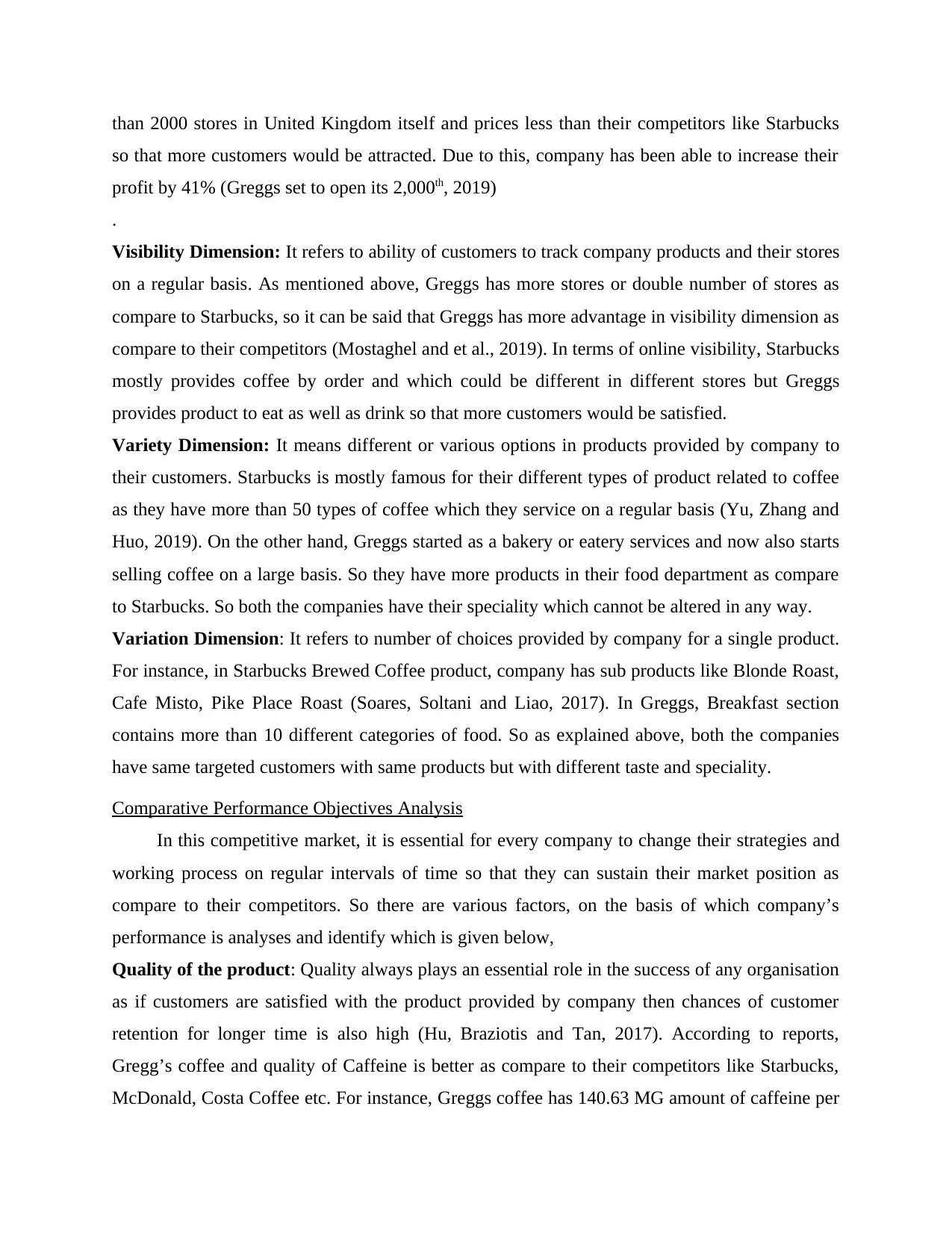
than 2000 stores in United Kingdom itself and prices less than their competitors like Starbucks
so that more customers would be attracted. Due to this, company has been able to increase their
profit by 41% (Greggs set to open its 2,000th, 2019)
.
Visibility Dimension: It refers to ability of customers to track company products and their stores
on a regular basis. As mentioned above, Greggs has more stores or double number of stores as
compare to Starbucks, so it can be said that Greggs has more advantage in visibility dimension as
compare to their competitors (Mostaghel and et al., 2019). In terms of online visibility, Starbucks
mostly provides coffee by order and which could be different in different stores but Greggs
provides product to eat as well as drink so that more customers would be satisfied.
Variety Dimension: It means different or various options in products provided by company to
their customers. Starbucks is mostly famous for their different types of product related to coffee
as they have more than 50 types of coffee which they service on a regular basis (Yu, Zhang and
Huo, 2019). On the other hand, Greggs started as a bakery or eatery services and now also starts
selling coffee on a large basis. So they have more products in their food department as compare
to Starbucks. So both the companies have their speciality which cannot be altered in any way.
Variation Dimension: It refers to number of choices provided by company for a single product.
For instance, in Starbucks Brewed Coffee product, company has sub products like Blonde Roast,
Cafe Misto, Pike Place Roast (Soares, Soltani and Liao, 2017). In Greggs, Breakfast section
contains more than 10 different categories of food. So as explained above, both the companies
have same targeted customers with same products but with different taste and speciality.
Comparative Performance Objectives Analysis
In this competitive market, it is essential for every company to change their strategies and
working process on regular intervals of time so that they can sustain their market position as
compare to their competitors. So there are various factors, on the basis of which company’s
performance is analyses and identify which is given below,
Quality of the product: Quality always plays an essential role in the success of any organisation
as if customers are satisfied with the product provided by company then chances of customer
retention for longer time is also high (Hu, Braziotis and Tan, 2017). According to reports,
Gregg’s coffee and quality of Caffeine is better as compare to their competitors like Starbucks,
McDonald, Costa Coffee etc. For instance, Greggs coffee has 140.63 MG amount of caffeine per
so that more customers would be attracted. Due to this, company has been able to increase their
profit by 41% (Greggs set to open its 2,000th, 2019)
.
Visibility Dimension: It refers to ability of customers to track company products and their stores
on a regular basis. As mentioned above, Greggs has more stores or double number of stores as
compare to Starbucks, so it can be said that Greggs has more advantage in visibility dimension as
compare to their competitors (Mostaghel and et al., 2019). In terms of online visibility, Starbucks
mostly provides coffee by order and which could be different in different stores but Greggs
provides product to eat as well as drink so that more customers would be satisfied.
Variety Dimension: It means different or various options in products provided by company to
their customers. Starbucks is mostly famous for their different types of product related to coffee
as they have more than 50 types of coffee which they service on a regular basis (Yu, Zhang and
Huo, 2019). On the other hand, Greggs started as a bakery or eatery services and now also starts
selling coffee on a large basis. So they have more products in their food department as compare
to Starbucks. So both the companies have their speciality which cannot be altered in any way.
Variation Dimension: It refers to number of choices provided by company for a single product.
For instance, in Starbucks Brewed Coffee product, company has sub products like Blonde Roast,
Cafe Misto, Pike Place Roast (Soares, Soltani and Liao, 2017). In Greggs, Breakfast section
contains more than 10 different categories of food. So as explained above, both the companies
have same targeted customers with same products but with different taste and speciality.
Comparative Performance Objectives Analysis
In this competitive market, it is essential for every company to change their strategies and
working process on regular intervals of time so that they can sustain their market position as
compare to their competitors. So there are various factors, on the basis of which company’s
performance is analyses and identify which is given below,
Quality of the product: Quality always plays an essential role in the success of any organisation
as if customers are satisfied with the product provided by company then chances of customer
retention for longer time is also high (Hu, Braziotis and Tan, 2017). According to reports,
Gregg’s coffee and quality of Caffeine is better as compare to their competitors like Starbucks,
McDonald, Costa Coffee etc. For instance, Greggs coffee has 140.63 MG amount of caffeine per
Paraphrase This Document
Need a fresh take? Get an instant paraphrase of this document with our AI Paraphraser
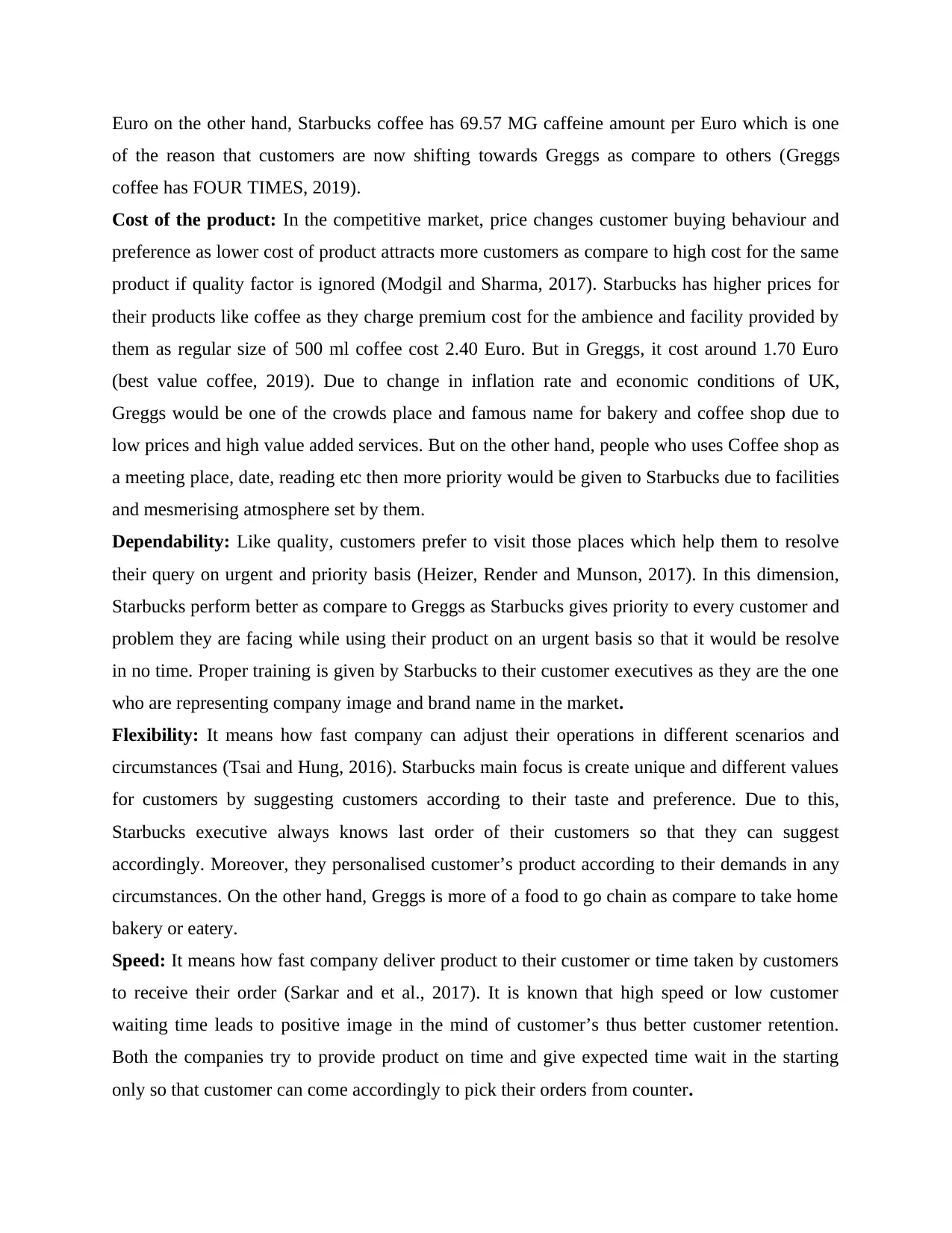
Euro on the other hand, Starbucks coffee has 69.57 MG caffeine amount per Euro which is one
of the reason that customers are now shifting towards Greggs as compare to others (Greggs
coffee has FOUR TIMES, 2019).
Cost of the product: In the competitive market, price changes customer buying behaviour and
preference as lower cost of product attracts more customers as compare to high cost for the same
product if quality factor is ignored (Modgil and Sharma, 2017). Starbucks has higher prices for
their products like coffee as they charge premium cost for the ambience and facility provided by
them as regular size of 500 ml coffee cost 2.40 Euro. But in Greggs, it cost around 1.70 Euro
(best value coffee, 2019). Due to change in inflation rate and economic conditions of UK,
Greggs would be one of the crowds place and famous name for bakery and coffee shop due to
low prices and high value added services. But on the other hand, people who uses Coffee shop as
a meeting place, date, reading etc then more priority would be given to Starbucks due to facilities
and mesmerising atmosphere set by them.
Dependability: Like quality, customers prefer to visit those places which help them to resolve
their query on urgent and priority basis (Heizer, Render and Munson, 2017). In this dimension,
Starbucks perform better as compare to Greggs as Starbucks gives priority to every customer and
problem they are facing while using their product on an urgent basis so that it would be resolve
in no time. Proper training is given by Starbucks to their customer executives as they are the one
who are representing company image and brand name in the market.
Flexibility: It means how fast company can adjust their operations in different scenarios and
circumstances (Tsai and Hung, 2016). Starbucks main focus is create unique and different values
for customers by suggesting customers according to their taste and preference. Due to this,
Starbucks executive always knows last order of their customers so that they can suggest
accordingly. Moreover, they personalised customer’s product according to their demands in any
circumstances. On the other hand, Greggs is more of a food to go chain as compare to take home
bakery or eatery.
Speed: It means how fast company deliver product to their customer or time taken by customers
to receive their order (Sarkar and et al., 2017). It is known that high speed or low customer
waiting time leads to positive image in the mind of customer’s thus better customer retention.
Both the companies try to provide product on time and give expected time wait in the starting
only so that customer can come accordingly to pick their orders from counter.
of the reason that customers are now shifting towards Greggs as compare to others (Greggs
coffee has FOUR TIMES, 2019).
Cost of the product: In the competitive market, price changes customer buying behaviour and
preference as lower cost of product attracts more customers as compare to high cost for the same
product if quality factor is ignored (Modgil and Sharma, 2017). Starbucks has higher prices for
their products like coffee as they charge premium cost for the ambience and facility provided by
them as regular size of 500 ml coffee cost 2.40 Euro. But in Greggs, it cost around 1.70 Euro
(best value coffee, 2019). Due to change in inflation rate and economic conditions of UK,
Greggs would be one of the crowds place and famous name for bakery and coffee shop due to
low prices and high value added services. But on the other hand, people who uses Coffee shop as
a meeting place, date, reading etc then more priority would be given to Starbucks due to facilities
and mesmerising atmosphere set by them.
Dependability: Like quality, customers prefer to visit those places which help them to resolve
their query on urgent and priority basis (Heizer, Render and Munson, 2017). In this dimension,
Starbucks perform better as compare to Greggs as Starbucks gives priority to every customer and
problem they are facing while using their product on an urgent basis so that it would be resolve
in no time. Proper training is given by Starbucks to their customer executives as they are the one
who are representing company image and brand name in the market.
Flexibility: It means how fast company can adjust their operations in different scenarios and
circumstances (Tsai and Hung, 2016). Starbucks main focus is create unique and different values
for customers by suggesting customers according to their taste and preference. Due to this,
Starbucks executive always knows last order of their customers so that they can suggest
accordingly. Moreover, they personalised customer’s product according to their demands in any
circumstances. On the other hand, Greggs is more of a food to go chain as compare to take home
bakery or eatery.
Speed: It means how fast company deliver product to their customer or time taken by customers
to receive their order (Sarkar and et al., 2017). It is known that high speed or low customer
waiting time leads to positive image in the mind of customer’s thus better customer retention.
Both the companies try to provide product on time and give expected time wait in the starting
only so that customer can come accordingly to pick their orders from counter.
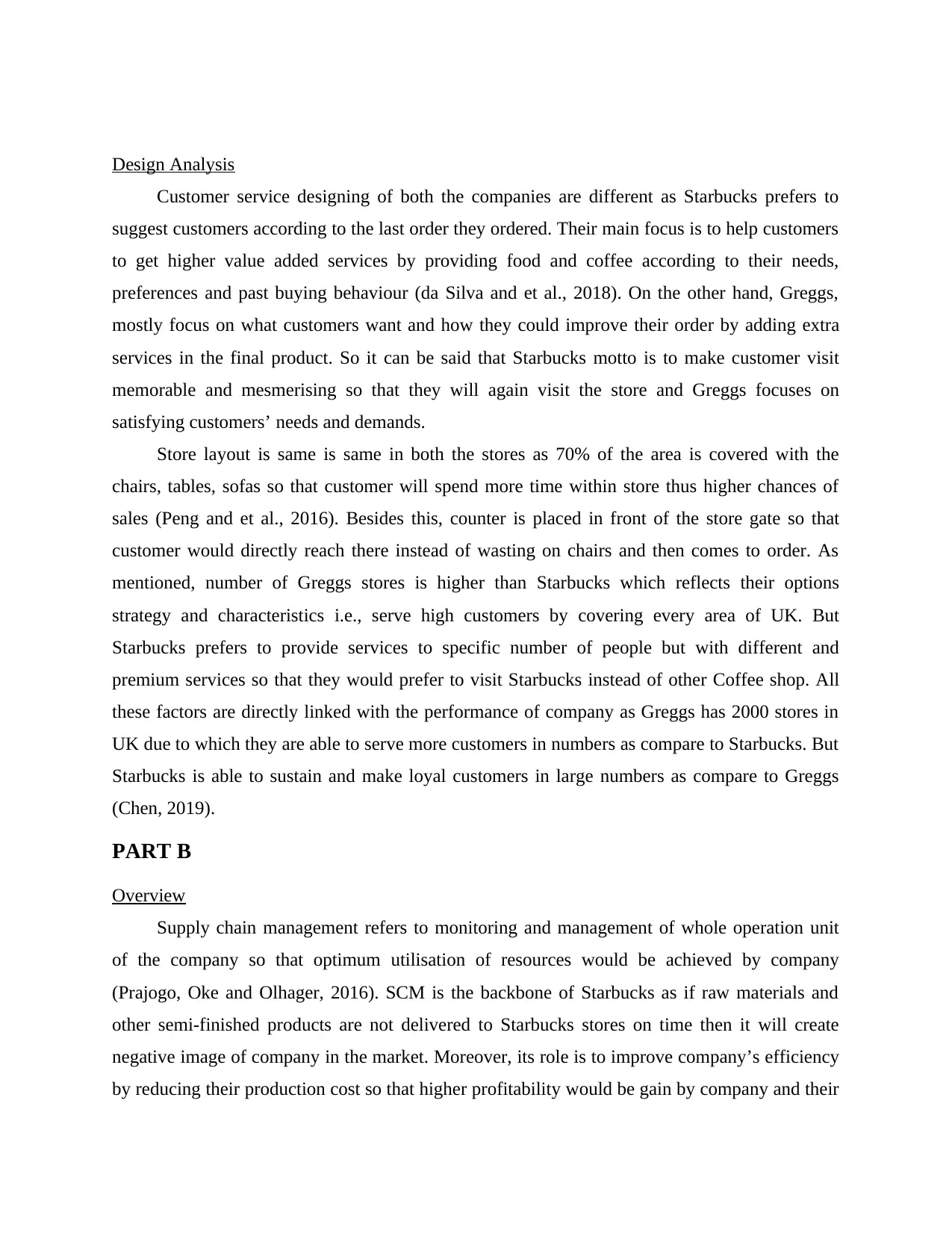
Design Analysis
Customer service designing of both the companies are different as Starbucks prefers to
suggest customers according to the last order they ordered. Their main focus is to help customers
to get higher value added services by providing food and coffee according to their needs,
preferences and past buying behaviour (da Silva and et al., 2018). On the other hand, Greggs,
mostly focus on what customers want and how they could improve their order by adding extra
services in the final product. So it can be said that Starbucks motto is to make customer visit
memorable and mesmerising so that they will again visit the store and Greggs focuses on
satisfying customers’ needs and demands.
Store layout is same is same in both the stores as 70% of the area is covered with the
chairs, tables, sofas so that customer will spend more time within store thus higher chances of
sales (Peng and et al., 2016). Besides this, counter is placed in front of the store gate so that
customer would directly reach there instead of wasting on chairs and then comes to order. As
mentioned, number of Greggs stores is higher than Starbucks which reflects their options
strategy and characteristics i.e., serve high customers by covering every area of UK. But
Starbucks prefers to provide services to specific number of people but with different and
premium services so that they would prefer to visit Starbucks instead of other Coffee shop. All
these factors are directly linked with the performance of company as Greggs has 2000 stores in
UK due to which they are able to serve more customers in numbers as compare to Starbucks. But
Starbucks is able to sustain and make loyal customers in large numbers as compare to Greggs
(Chen, 2019).
PART B
Overview
Supply chain management refers to monitoring and management of whole operation unit
of the company so that optimum utilisation of resources would be achieved by company
(Prajogo, Oke and Olhager, 2016). SCM is the backbone of Starbucks as if raw materials and
other semi-finished products are not delivered to Starbucks stores on time then it will create
negative image of company in the market. Moreover, its role is to improve company’s efficiency
by reducing their production cost so that higher profitability would be gain by company and their
Customer service designing of both the companies are different as Starbucks prefers to
suggest customers according to the last order they ordered. Their main focus is to help customers
to get higher value added services by providing food and coffee according to their needs,
preferences and past buying behaviour (da Silva and et al., 2018). On the other hand, Greggs,
mostly focus on what customers want and how they could improve their order by adding extra
services in the final product. So it can be said that Starbucks motto is to make customer visit
memorable and mesmerising so that they will again visit the store and Greggs focuses on
satisfying customers’ needs and demands.
Store layout is same is same in both the stores as 70% of the area is covered with the
chairs, tables, sofas so that customer will spend more time within store thus higher chances of
sales (Peng and et al., 2016). Besides this, counter is placed in front of the store gate so that
customer would directly reach there instead of wasting on chairs and then comes to order. As
mentioned, number of Greggs stores is higher than Starbucks which reflects their options
strategy and characteristics i.e., serve high customers by covering every area of UK. But
Starbucks prefers to provide services to specific number of people but with different and
premium services so that they would prefer to visit Starbucks instead of other Coffee shop. All
these factors are directly linked with the performance of company as Greggs has 2000 stores in
UK due to which they are able to serve more customers in numbers as compare to Starbucks. But
Starbucks is able to sustain and make loyal customers in large numbers as compare to Greggs
(Chen, 2019).
PART B
Overview
Supply chain management refers to monitoring and management of whole operation unit
of the company so that optimum utilisation of resources would be achieved by company
(Prajogo, Oke and Olhager, 2016). SCM is the backbone of Starbucks as if raw materials and
other semi-finished products are not delivered to Starbucks stores on time then it will create
negative image of company in the market. Moreover, its role is to improve company’s efficiency
by reducing their production cost so that higher profitability would be gain by company and their
⊘ This is a preview!⊘
Do you want full access?
Subscribe today to unlock all pages.

Trusted by 1+ million students worldwide
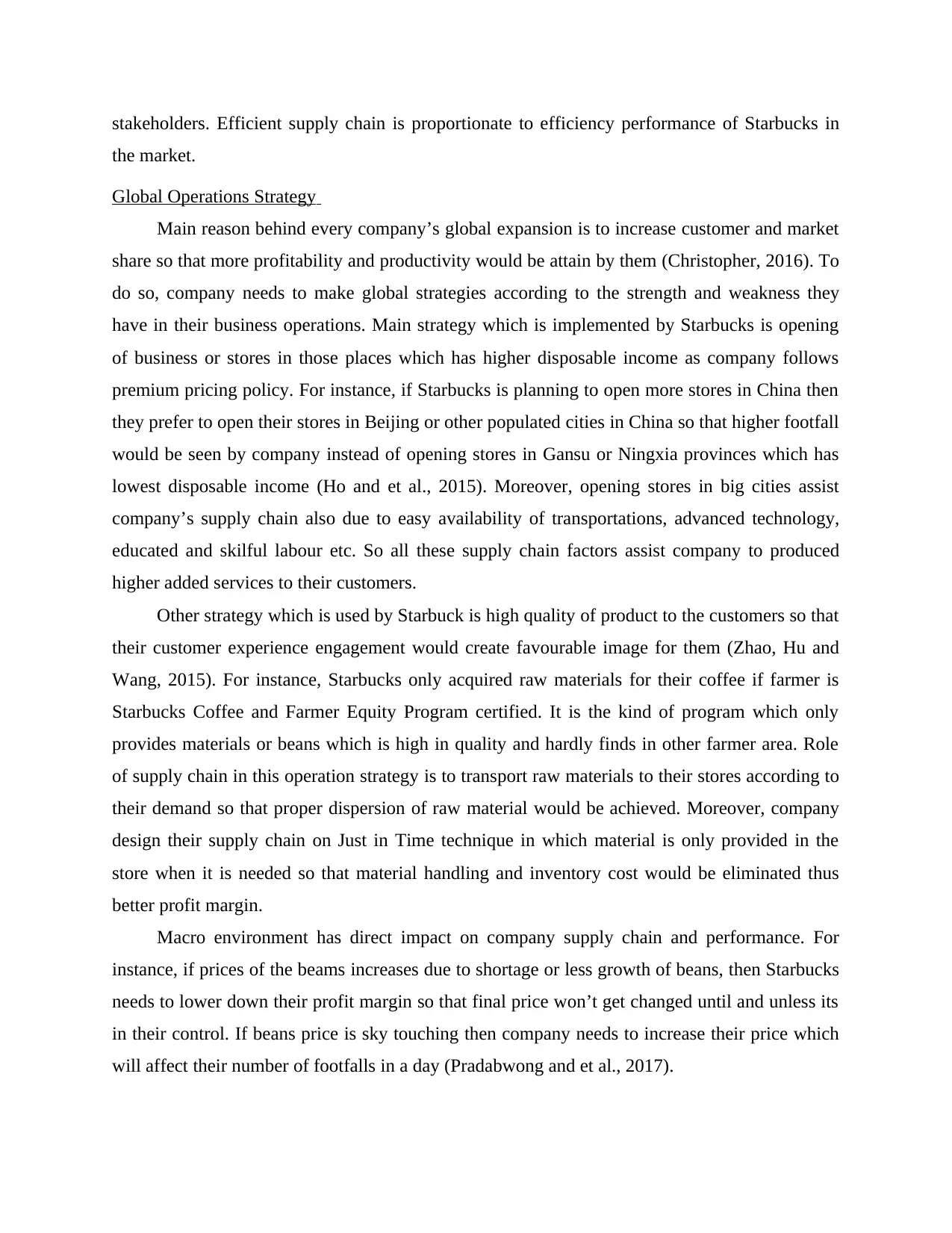
stakeholders. Efficient supply chain is proportionate to efficiency performance of Starbucks in
the market.
Global Operations Strategy
Main reason behind every company’s global expansion is to increase customer and market
share so that more profitability and productivity would be attain by them (Christopher, 2016). To
do so, company needs to make global strategies according to the strength and weakness they
have in their business operations. Main strategy which is implemented by Starbucks is opening
of business or stores in those places which has higher disposable income as company follows
premium pricing policy. For instance, if Starbucks is planning to open more stores in China then
they prefer to open their stores in Beijing or other populated cities in China so that higher footfall
would be seen by company instead of opening stores in Gansu or Ningxia provinces which has
lowest disposable income (Ho and et al., 2015). Moreover, opening stores in big cities assist
company’s supply chain also due to easy availability of transportations, advanced technology,
educated and skilful labour etc. So all these supply chain factors assist company to produced
higher added services to their customers.
Other strategy which is used by Starbuck is high quality of product to the customers so that
their customer experience engagement would create favourable image for them (Zhao, Hu and
Wang, 2015). For instance, Starbucks only acquired raw materials for their coffee if farmer is
Starbucks Coffee and Farmer Equity Program certified. It is the kind of program which only
provides materials or beans which is high in quality and hardly finds in other farmer area. Role
of supply chain in this operation strategy is to transport raw materials to their stores according to
their demand so that proper dispersion of raw material would be achieved. Moreover, company
design their supply chain on Just in Time technique in which material is only provided in the
store when it is needed so that material handling and inventory cost would be eliminated thus
better profit margin.
Macro environment has direct impact on company supply chain and performance. For
instance, if prices of the beams increases due to shortage or less growth of beans, then Starbucks
needs to lower down their profit margin so that final price won’t get changed until and unless its
in their control. If beans price is sky touching then company needs to increase their price which
will affect their number of footfalls in a day (Pradabwong and et al., 2017).
the market.
Global Operations Strategy
Main reason behind every company’s global expansion is to increase customer and market
share so that more profitability and productivity would be attain by them (Christopher, 2016). To
do so, company needs to make global strategies according to the strength and weakness they
have in their business operations. Main strategy which is implemented by Starbucks is opening
of business or stores in those places which has higher disposable income as company follows
premium pricing policy. For instance, if Starbucks is planning to open more stores in China then
they prefer to open their stores in Beijing or other populated cities in China so that higher footfall
would be seen by company instead of opening stores in Gansu or Ningxia provinces which has
lowest disposable income (Ho and et al., 2015). Moreover, opening stores in big cities assist
company’s supply chain also due to easy availability of transportations, advanced technology,
educated and skilful labour etc. So all these supply chain factors assist company to produced
higher added services to their customers.
Other strategy which is used by Starbuck is high quality of product to the customers so that
their customer experience engagement would create favourable image for them (Zhao, Hu and
Wang, 2015). For instance, Starbucks only acquired raw materials for their coffee if farmer is
Starbucks Coffee and Farmer Equity Program certified. It is the kind of program which only
provides materials or beans which is high in quality and hardly finds in other farmer area. Role
of supply chain in this operation strategy is to transport raw materials to their stores according to
their demand so that proper dispersion of raw material would be achieved. Moreover, company
design their supply chain on Just in Time technique in which material is only provided in the
store when it is needed so that material handling and inventory cost would be eliminated thus
better profit margin.
Macro environment has direct impact on company supply chain and performance. For
instance, if prices of the beams increases due to shortage or less growth of beans, then Starbucks
needs to lower down their profit margin so that final price won’t get changed until and unless its
in their control. If beans price is sky touching then company needs to increase their price which
will affect their number of footfalls in a day (Pradabwong and et al., 2017).
Paraphrase This Document
Need a fresh take? Get an instant paraphrase of this document with our AI Paraphraser
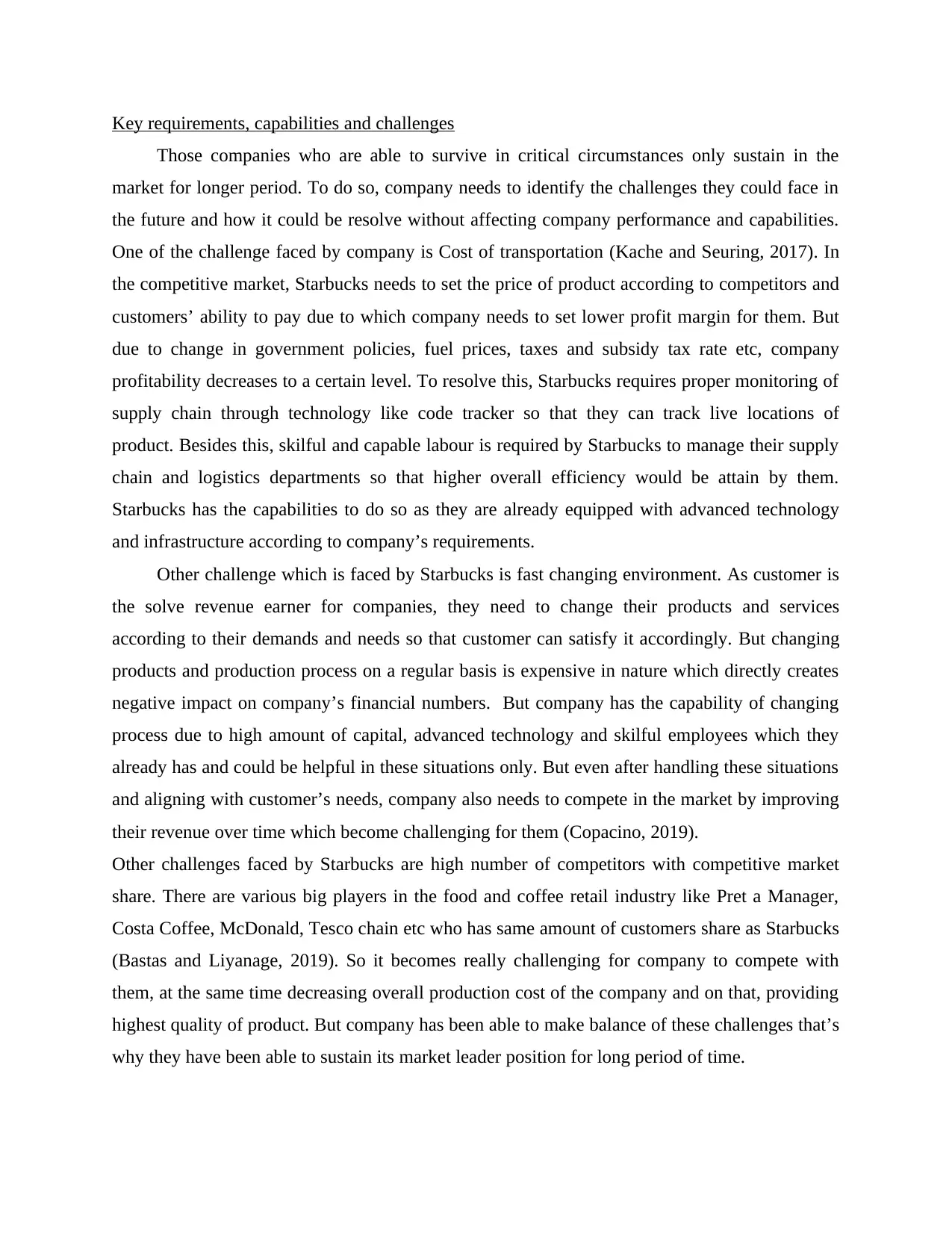
Key requirements, capabilities and challenges
Those companies who are able to survive in critical circumstances only sustain in the
market for longer period. To do so, company needs to identify the challenges they could face in
the future and how it could be resolve without affecting company performance and capabilities.
One of the challenge faced by company is Cost of transportation (Kache and Seuring, 2017). In
the competitive market, Starbucks needs to set the price of product according to competitors and
customers’ ability to pay due to which company needs to set lower profit margin for them. But
due to change in government policies, fuel prices, taxes and subsidy tax rate etc, company
profitability decreases to a certain level. To resolve this, Starbucks requires proper monitoring of
supply chain through technology like code tracker so that they can track live locations of
product. Besides this, skilful and capable labour is required by Starbucks to manage their supply
chain and logistics departments so that higher overall efficiency would be attain by them.
Starbucks has the capabilities to do so as they are already equipped with advanced technology
and infrastructure according to company’s requirements.
Other challenge which is faced by Starbucks is fast changing environment. As customer is
the solve revenue earner for companies, they need to change their products and services
according to their demands and needs so that customer can satisfy it accordingly. But changing
products and production process on a regular basis is expensive in nature which directly creates
negative impact on company’s financial numbers. But company has the capability of changing
process due to high amount of capital, advanced technology and skilful employees which they
already has and could be helpful in these situations only. But even after handling these situations
and aligning with customer’s needs, company also needs to compete in the market by improving
their revenue over time which become challenging for them (Copacino, 2019).
Other challenges faced by Starbucks are high number of competitors with competitive market
share. There are various big players in the food and coffee retail industry like Pret a Manager,
Costa Coffee, McDonald, Tesco chain etc who has same amount of customers share as Starbucks
(Bastas and Liyanage, 2019). So it becomes really challenging for company to compete with
them, at the same time decreasing overall production cost of the company and on that, providing
highest quality of product. But company has been able to make balance of these challenges that’s
why they have been able to sustain its market leader position for long period of time.
Those companies who are able to survive in critical circumstances only sustain in the
market for longer period. To do so, company needs to identify the challenges they could face in
the future and how it could be resolve without affecting company performance and capabilities.
One of the challenge faced by company is Cost of transportation (Kache and Seuring, 2017). In
the competitive market, Starbucks needs to set the price of product according to competitors and
customers’ ability to pay due to which company needs to set lower profit margin for them. But
due to change in government policies, fuel prices, taxes and subsidy tax rate etc, company
profitability decreases to a certain level. To resolve this, Starbucks requires proper monitoring of
supply chain through technology like code tracker so that they can track live locations of
product. Besides this, skilful and capable labour is required by Starbucks to manage their supply
chain and logistics departments so that higher overall efficiency would be attain by them.
Starbucks has the capabilities to do so as they are already equipped with advanced technology
and infrastructure according to company’s requirements.
Other challenge which is faced by Starbucks is fast changing environment. As customer is
the solve revenue earner for companies, they need to change their products and services
according to their demands and needs so that customer can satisfy it accordingly. But changing
products and production process on a regular basis is expensive in nature which directly creates
negative impact on company’s financial numbers. But company has the capability of changing
process due to high amount of capital, advanced technology and skilful employees which they
already has and could be helpful in these situations only. But even after handling these situations
and aligning with customer’s needs, company also needs to compete in the market by improving
their revenue over time which become challenging for them (Copacino, 2019).
Other challenges faced by Starbucks are high number of competitors with competitive market
share. There are various big players in the food and coffee retail industry like Pret a Manager,
Costa Coffee, McDonald, Tesco chain etc who has same amount of customers share as Starbucks
(Bastas and Liyanage, 2019). So it becomes really challenging for company to compete with
them, at the same time decreasing overall production cost of the company and on that, providing
highest quality of product. But company has been able to make balance of these challenges that’s
why they have been able to sustain its market leader position for long period of time.
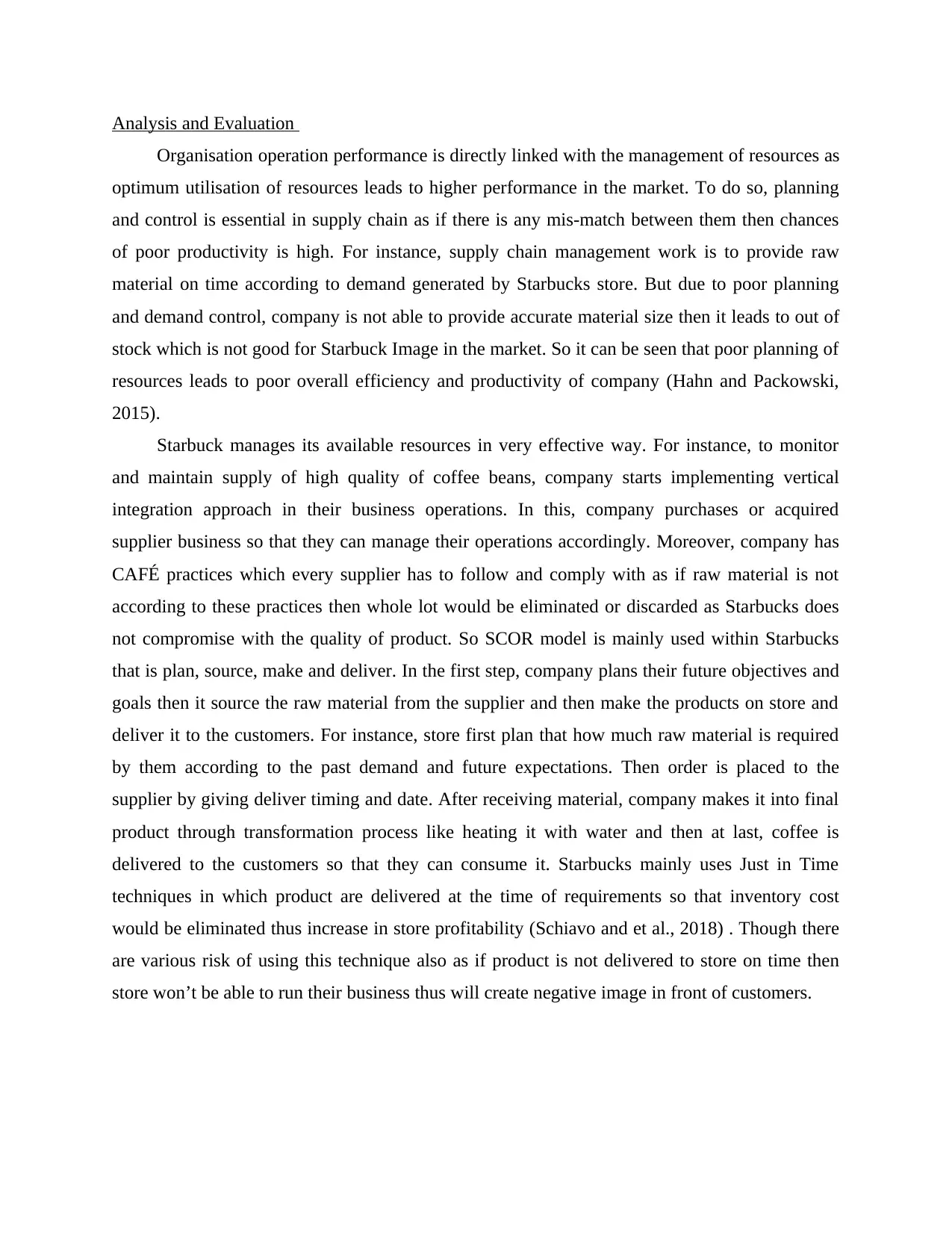
Analysis and Evaluation
Organisation operation performance is directly linked with the management of resources as
optimum utilisation of resources leads to higher performance in the market. To do so, planning
and control is essential in supply chain as if there is any mis-match between them then chances
of poor productivity is high. For instance, supply chain management work is to provide raw
material on time according to demand generated by Starbucks store. But due to poor planning
and demand control, company is not able to provide accurate material size then it leads to out of
stock which is not good for Starbuck Image in the market. So it can be seen that poor planning of
resources leads to poor overall efficiency and productivity of company (Hahn and Packowski,
2015).
Starbuck manages its available resources in very effective way. For instance, to monitor
and maintain supply of high quality of coffee beans, company starts implementing vertical
integration approach in their business operations. In this, company purchases or acquired
supplier business so that they can manage their operations accordingly. Moreover, company has
CAFÉ practices which every supplier has to follow and comply with as if raw material is not
according to these practices then whole lot would be eliminated or discarded as Starbucks does
not compromise with the quality of product. So SCOR model is mainly used within Starbucks
that is plan, source, make and deliver. In the first step, company plans their future objectives and
goals then it source the raw material from the supplier and then make the products on store and
deliver it to the customers. For instance, store first plan that how much raw material is required
by them according to the past demand and future expectations. Then order is placed to the
supplier by giving deliver timing and date. After receiving material, company makes it into final
product through transformation process like heating it with water and then at last, coffee is
delivered to the customers so that they can consume it. Starbucks mainly uses Just in Time
techniques in which product are delivered at the time of requirements so that inventory cost
would be eliminated thus increase in store profitability (Schiavo and et al., 2018) . Though there
are various risk of using this technique also as if product is not delivered to store on time then
store won’t be able to run their business thus will create negative image in front of customers.
Organisation operation performance is directly linked with the management of resources as
optimum utilisation of resources leads to higher performance in the market. To do so, planning
and control is essential in supply chain as if there is any mis-match between them then chances
of poor productivity is high. For instance, supply chain management work is to provide raw
material on time according to demand generated by Starbucks store. But due to poor planning
and demand control, company is not able to provide accurate material size then it leads to out of
stock which is not good for Starbuck Image in the market. So it can be seen that poor planning of
resources leads to poor overall efficiency and productivity of company (Hahn and Packowski,
2015).
Starbuck manages its available resources in very effective way. For instance, to monitor
and maintain supply of high quality of coffee beans, company starts implementing vertical
integration approach in their business operations. In this, company purchases or acquired
supplier business so that they can manage their operations accordingly. Moreover, company has
CAFÉ practices which every supplier has to follow and comply with as if raw material is not
according to these practices then whole lot would be eliminated or discarded as Starbucks does
not compromise with the quality of product. So SCOR model is mainly used within Starbucks
that is plan, source, make and deliver. In the first step, company plans their future objectives and
goals then it source the raw material from the supplier and then make the products on store and
deliver it to the customers. For instance, store first plan that how much raw material is required
by them according to the past demand and future expectations. Then order is placed to the
supplier by giving deliver timing and date. After receiving material, company makes it into final
product through transformation process like heating it with water and then at last, coffee is
delivered to the customers so that they can consume it. Starbucks mainly uses Just in Time
techniques in which product are delivered at the time of requirements so that inventory cost
would be eliminated thus increase in store profitability (Schiavo and et al., 2018) . Though there
are various risk of using this technique also as if product is not delivered to store on time then
store won’t be able to run their business thus will create negative image in front of customers.
⊘ This is a preview!⊘
Do you want full access?
Subscribe today to unlock all pages.

Trusted by 1+ million students worldwide
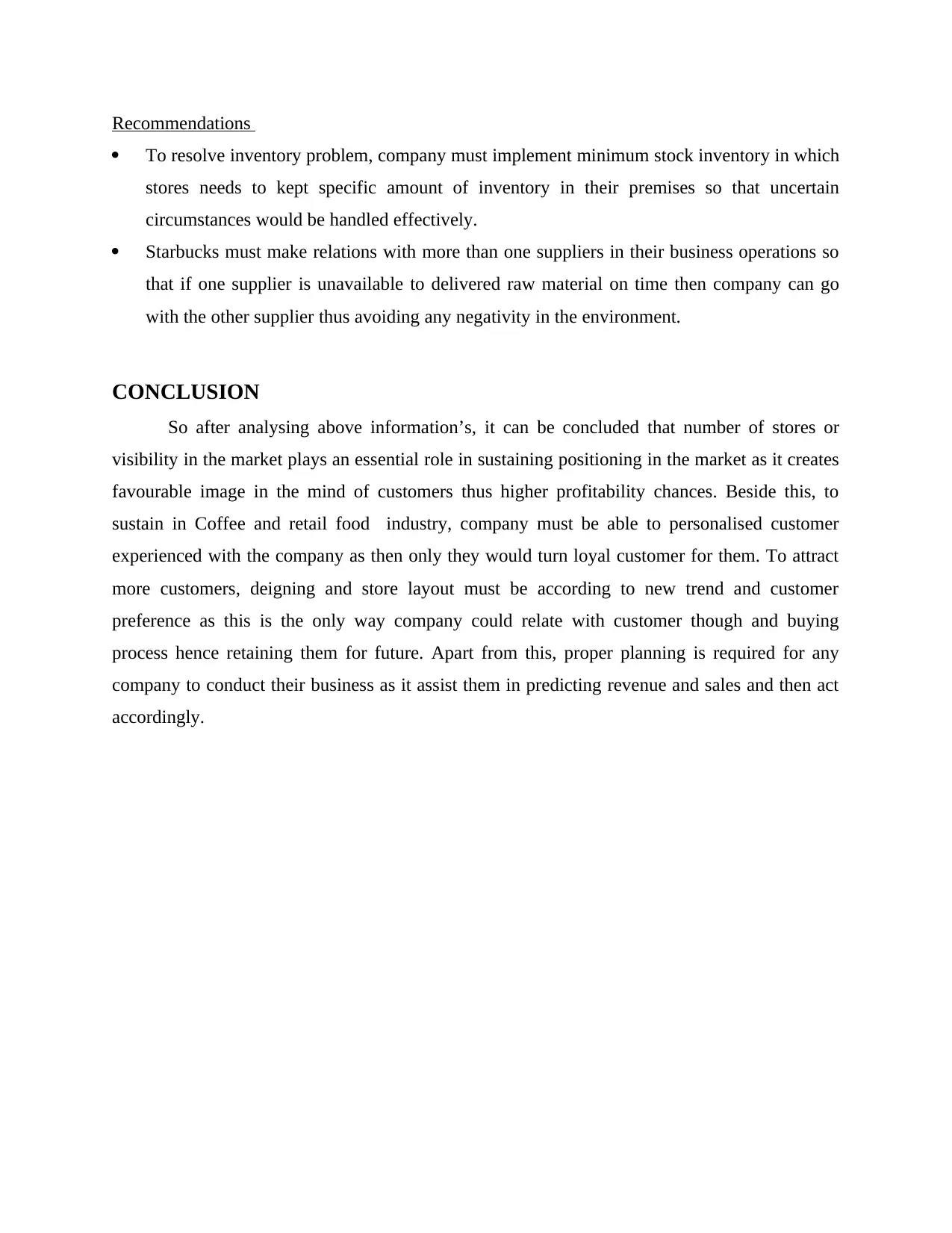
Recommendations
To resolve inventory problem, company must implement minimum stock inventory in which
stores needs to kept specific amount of inventory in their premises so that uncertain
circumstances would be handled effectively.
Starbucks must make relations with more than one suppliers in their business operations so
that if one supplier is unavailable to delivered raw material on time then company can go
with the other supplier thus avoiding any negativity in the environment.
CONCLUSION
So after analysing above information’s, it can be concluded that number of stores or
visibility in the market plays an essential role in sustaining positioning in the market as it creates
favourable image in the mind of customers thus higher profitability chances. Beside this, to
sustain in Coffee and retail food industry, company must be able to personalised customer
experienced with the company as then only they would turn loyal customer for them. To attract
more customers, deigning and store layout must be according to new trend and customer
preference as this is the only way company could relate with customer though and buying
process hence retaining them for future. Apart from this, proper planning is required for any
company to conduct their business as it assist them in predicting revenue and sales and then act
accordingly.
To resolve inventory problem, company must implement minimum stock inventory in which
stores needs to kept specific amount of inventory in their premises so that uncertain
circumstances would be handled effectively.
Starbucks must make relations with more than one suppliers in their business operations so
that if one supplier is unavailable to delivered raw material on time then company can go
with the other supplier thus avoiding any negativity in the environment.
CONCLUSION
So after analysing above information’s, it can be concluded that number of stores or
visibility in the market plays an essential role in sustaining positioning in the market as it creates
favourable image in the mind of customers thus higher profitability chances. Beside this, to
sustain in Coffee and retail food industry, company must be able to personalised customer
experienced with the company as then only they would turn loyal customer for them. To attract
more customers, deigning and store layout must be according to new trend and customer
preference as this is the only way company could relate with customer though and buying
process hence retaining them for future. Apart from this, proper planning is required for any
company to conduct their business as it assist them in predicting revenue and sales and then act
accordingly.
Paraphrase This Document
Need a fresh take? Get an instant paraphrase of this document with our AI Paraphraser
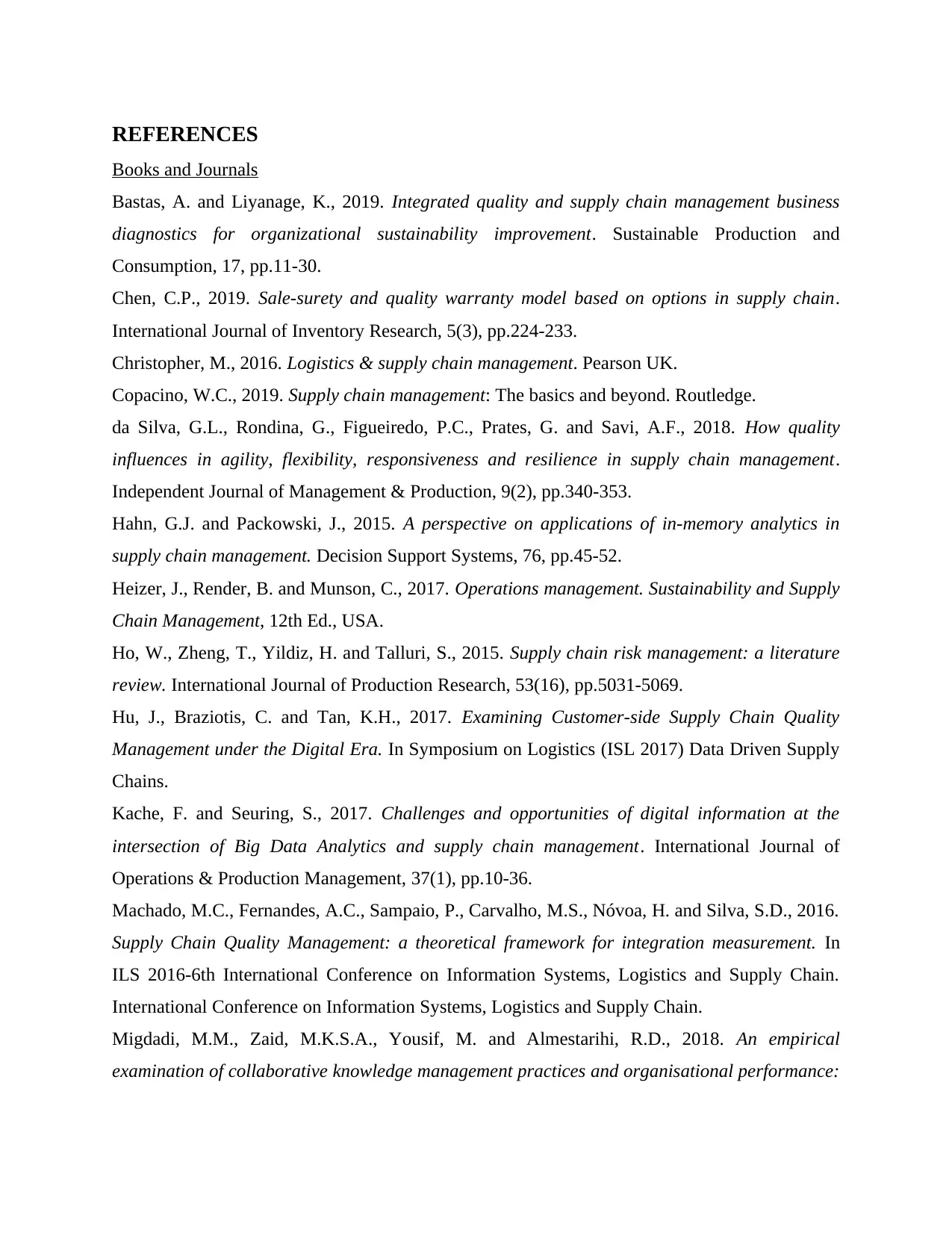
REFERENCES
Books and Journals
Bastas, A. and Liyanage, K., 2019. Integrated quality and supply chain management business
diagnostics for organizational sustainability improvement. Sustainable Production and
Consumption, 17, pp.11-30.
Chen, C.P., 2019. Sale-surety and quality warranty model based on options in supply chain.
International Journal of Inventory Research, 5(3), pp.224-233.
Christopher, M., 2016. Logistics & supply chain management. Pearson UK.
Copacino, W.C., 2019. Supply chain management: The basics and beyond. Routledge.
da Silva, G.L., Rondina, G., Figueiredo, P.C., Prates, G. and Savi, A.F., 2018. How quality
influences in agility, flexibility, responsiveness and resilience in supply chain management.
Independent Journal of Management & Production, 9(2), pp.340-353.
Hahn, G.J. and Packowski, J., 2015. A perspective on applications of in-memory analytics in
supply chain management. Decision Support Systems, 76, pp.45-52.
Heizer, J., Render, B. and Munson, C., 2017. Operations management. Sustainability and Supply
Chain Management, 12th Ed., USA.
Ho, W., Zheng, T., Yildiz, H. and Talluri, S., 2015. Supply chain risk management: a literature
review. International Journal of Production Research, 53(16), pp.5031-5069.
Hu, J., Braziotis, C. and Tan, K.H., 2017. Examining Customer-side Supply Chain Quality
Management under the Digital Era. In Symposium on Logistics (ISL 2017) Data Driven Supply
Chains.
Kache, F. and Seuring, S., 2017. Challenges and opportunities of digital information at the
intersection of Big Data Analytics and supply chain management. International Journal of
Operations & Production Management, 37(1), pp.10-36.
Machado, M.C., Fernandes, A.C., Sampaio, P., Carvalho, M.S., Nóvoa, H. and Silva, S.D., 2016.
Supply Chain Quality Management: a theoretical framework for integration measurement. In
ILS 2016-6th International Conference on Information Systems, Logistics and Supply Chain.
International Conference on Information Systems, Logistics and Supply Chain.
Migdadi, M.M., Zaid, M.K.S.A., Yousif, M. and Almestarihi, R.D., 2018. An empirical
examination of collaborative knowledge management practices and organisational performance:
Books and Journals
Bastas, A. and Liyanage, K., 2019. Integrated quality and supply chain management business
diagnostics for organizational sustainability improvement. Sustainable Production and
Consumption, 17, pp.11-30.
Chen, C.P., 2019. Sale-surety and quality warranty model based on options in supply chain.
International Journal of Inventory Research, 5(3), pp.224-233.
Christopher, M., 2016. Logistics & supply chain management. Pearson UK.
Copacino, W.C., 2019. Supply chain management: The basics and beyond. Routledge.
da Silva, G.L., Rondina, G., Figueiredo, P.C., Prates, G. and Savi, A.F., 2018. How quality
influences in agility, flexibility, responsiveness and resilience in supply chain management.
Independent Journal of Management & Production, 9(2), pp.340-353.
Hahn, G.J. and Packowski, J., 2015. A perspective on applications of in-memory analytics in
supply chain management. Decision Support Systems, 76, pp.45-52.
Heizer, J., Render, B. and Munson, C., 2017. Operations management. Sustainability and Supply
Chain Management, 12th Ed., USA.
Ho, W., Zheng, T., Yildiz, H. and Talluri, S., 2015. Supply chain risk management: a literature
review. International Journal of Production Research, 53(16), pp.5031-5069.
Hu, J., Braziotis, C. and Tan, K.H., 2017. Examining Customer-side Supply Chain Quality
Management under the Digital Era. In Symposium on Logistics (ISL 2017) Data Driven Supply
Chains.
Kache, F. and Seuring, S., 2017. Challenges and opportunities of digital information at the
intersection of Big Data Analytics and supply chain management. International Journal of
Operations & Production Management, 37(1), pp.10-36.
Machado, M.C., Fernandes, A.C., Sampaio, P., Carvalho, M.S., Nóvoa, H. and Silva, S.D., 2016.
Supply Chain Quality Management: a theoretical framework for integration measurement. In
ILS 2016-6th International Conference on Information Systems, Logistics and Supply Chain.
International Conference on Information Systems, Logistics and Supply Chain.
Migdadi, M.M., Zaid, M.K.S.A., Yousif, M. and Almestarihi, R.D., 2018. An empirical
examination of collaborative knowledge management practices and organisational performance:
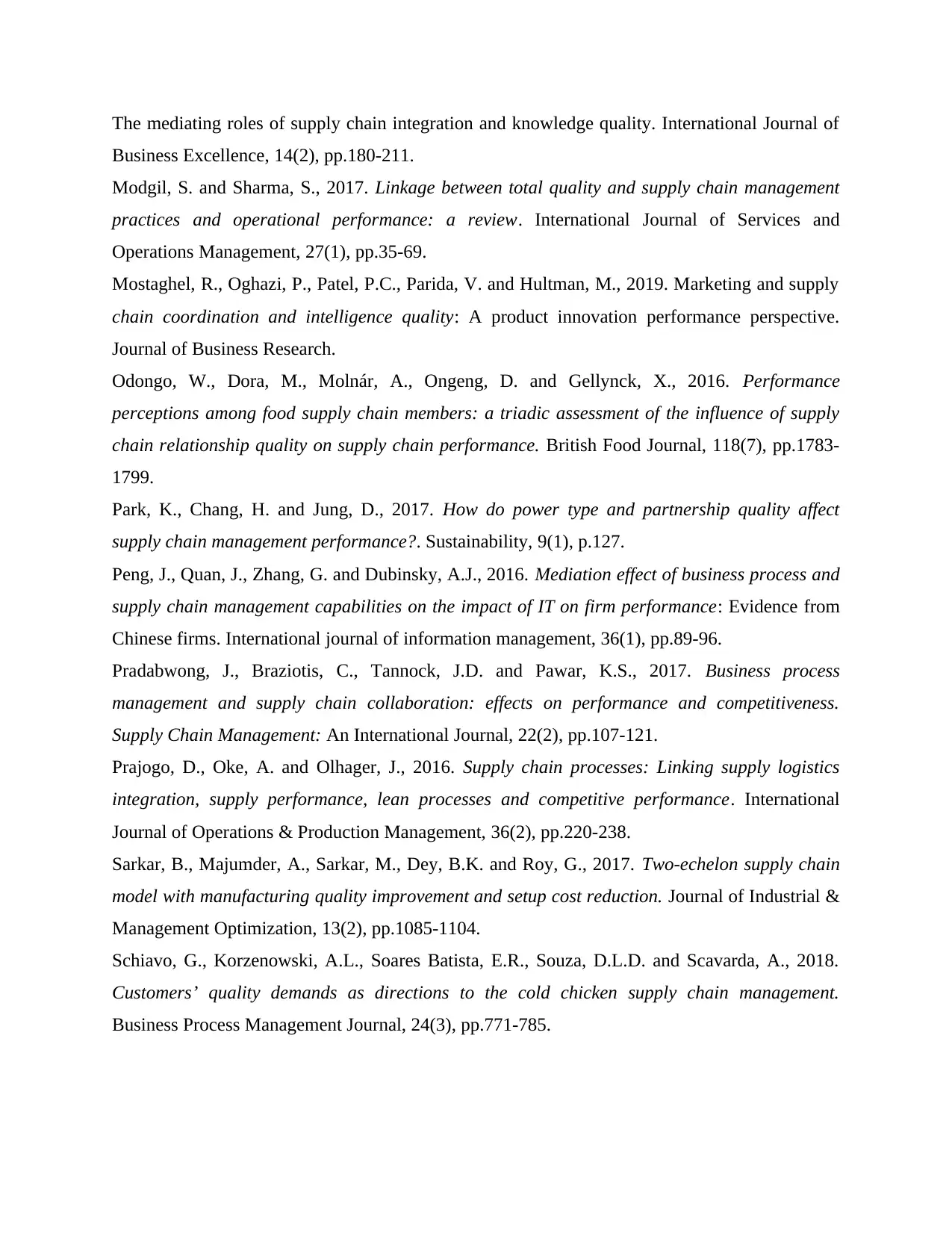
The mediating roles of supply chain integration and knowledge quality. International Journal of
Business Excellence, 14(2), pp.180-211.
Modgil, S. and Sharma, S., 2017. Linkage between total quality and supply chain management
practices and operational performance: a review. International Journal of Services and
Operations Management, 27(1), pp.35-69.
Mostaghel, R., Oghazi, P., Patel, P.C., Parida, V. and Hultman, M., 2019. Marketing and supply
chain coordination and intelligence quality: A product innovation performance perspective.
Journal of Business Research.
Odongo, W., Dora, M., Molnár, A., Ongeng, D. and Gellynck, X., 2016. Performance
perceptions among food supply chain members: a triadic assessment of the influence of supply
chain relationship quality on supply chain performance. British Food Journal, 118(7), pp.1783-
1799.
Park, K., Chang, H. and Jung, D., 2017. How do power type and partnership quality affect
supply chain management performance?. Sustainability, 9(1), p.127.
Peng, J., Quan, J., Zhang, G. and Dubinsky, A.J., 2016. Mediation effect of business process and
supply chain management capabilities on the impact of IT on firm performance: Evidence from
Chinese firms. International journal of information management, 36(1), pp.89-96.
Pradabwong, J., Braziotis, C., Tannock, J.D. and Pawar, K.S., 2017. Business process
management and supply chain collaboration: effects on performance and competitiveness.
Supply Chain Management: An International Journal, 22(2), pp.107-121.
Prajogo, D., Oke, A. and Olhager, J., 2016. Supply chain processes: Linking supply logistics
integration, supply performance, lean processes and competitive performance. International
Journal of Operations & Production Management, 36(2), pp.220-238.
Sarkar, B., Majumder, A., Sarkar, M., Dey, B.K. and Roy, G., 2017. Two-echelon supply chain
model with manufacturing quality improvement and setup cost reduction. Journal of Industrial &
Management Optimization, 13(2), pp.1085-1104.
Schiavo, G., Korzenowski, A.L., Soares Batista, E.R., Souza, D.L.D. and Scavarda, A., 2018.
Customers’ quality demands as directions to the cold chicken supply chain management.
Business Process Management Journal, 24(3), pp.771-785.
Business Excellence, 14(2), pp.180-211.
Modgil, S. and Sharma, S., 2017. Linkage between total quality and supply chain management
practices and operational performance: a review. International Journal of Services and
Operations Management, 27(1), pp.35-69.
Mostaghel, R., Oghazi, P., Patel, P.C., Parida, V. and Hultman, M., 2019. Marketing and supply
chain coordination and intelligence quality: A product innovation performance perspective.
Journal of Business Research.
Odongo, W., Dora, M., Molnár, A., Ongeng, D. and Gellynck, X., 2016. Performance
perceptions among food supply chain members: a triadic assessment of the influence of supply
chain relationship quality on supply chain performance. British Food Journal, 118(7), pp.1783-
1799.
Park, K., Chang, H. and Jung, D., 2017. How do power type and partnership quality affect
supply chain management performance?. Sustainability, 9(1), p.127.
Peng, J., Quan, J., Zhang, G. and Dubinsky, A.J., 2016. Mediation effect of business process and
supply chain management capabilities on the impact of IT on firm performance: Evidence from
Chinese firms. International journal of information management, 36(1), pp.89-96.
Pradabwong, J., Braziotis, C., Tannock, J.D. and Pawar, K.S., 2017. Business process
management and supply chain collaboration: effects on performance and competitiveness.
Supply Chain Management: An International Journal, 22(2), pp.107-121.
Prajogo, D., Oke, A. and Olhager, J., 2016. Supply chain processes: Linking supply logistics
integration, supply performance, lean processes and competitive performance. International
Journal of Operations & Production Management, 36(2), pp.220-238.
Sarkar, B., Majumder, A., Sarkar, M., Dey, B.K. and Roy, G., 2017. Two-echelon supply chain
model with manufacturing quality improvement and setup cost reduction. Journal of Industrial &
Management Optimization, 13(2), pp.1085-1104.
Schiavo, G., Korzenowski, A.L., Soares Batista, E.R., Souza, D.L.D. and Scavarda, A., 2018.
Customers’ quality demands as directions to the cold chicken supply chain management.
Business Process Management Journal, 24(3), pp.771-785.
⊘ This is a preview!⊘
Do you want full access?
Subscribe today to unlock all pages.

Trusted by 1+ million students worldwide
1 out of 13
Related Documents
Your All-in-One AI-Powered Toolkit for Academic Success.
+13062052269
info@desklib.com
Available 24*7 on WhatsApp / Email
![[object Object]](/_next/static/media/star-bottom.7253800d.svg)
Unlock your academic potential
Copyright © 2020–2025 A2Z Services. All Rights Reserved. Developed and managed by ZUCOL.





